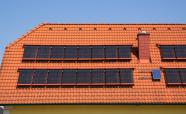Brighter Times Ahead for Solar
Banks backing Solar Rooftop Projects

Some say that solar energy is in a dark place. Others say that brighter days are ahead. While a bad economy has dampened investment in most new enterprises, green energy has fared relatively okay. Investors have rewarded solar the most.
Revving up the economy by modernizing the energy sector and funding sustainable investments is alive and well. Once the federal stimulus funds are exhausted, however, private investment must resume the lead. Indications are that this is now occurring.
San Francisco-based SunRun has just netted financing from U.S. Bancorp to develop solar systems for 1,900 homes. With this deal, SunRun has now has funding for about $400 million in solar systems. According to the company, it owns, maintains and insures the systems for their 20-year life. Systems are paid through some upfront fees along with monthly service charges and the normal cost of their electric service, plus SunRun gets federal tax subsidies and state rebates.
"We are the only home solar company to have enjoyed an uninterrupted source of project financing, and this steady stream of capital speaks directly to our credibility as a reliable and risk-free alternative to the utility," says SunRun's Chief Executive Edward Fenster. "U.S. Bancorp has been a fantastic long-term partner and instrumental in helping SunRun provide affordable and hassle-free solar to thousands of homeowners."
SunRun's experience may be a precursor of the industry's fate. Or maybe not. Times are still tough and the banks are reluctant to jump in with both feet. Indeed, that trepidation is why the Obama administration pushed through its stimulus plan - all to give shovel ready green energy projects the final oomph they required to get up and going.
According to Clean Edge, in 2009 overall venture capital spending fell to its lowest levels in a decade. That said, clean-tech investments rose from11.5 percent to12.5 percent from 2008 to 2009. Along with wind and bio-fuels, solar collected from venture capitalists about $144 billion during this time, although the solar industry witnessed a decrease in overall revenues because the price of those systems had dramatically declined.
Now, things are looking up for the whole economy, and clean energy has become a driving force in lifting those conditions. Clean Edge attributes that turnaround to the stimulus plan enacted in early 2008. At that time, about $100 billion of the $787 billion of the monies had been allocated go to clean-tech investments.
Specifically, Clean Edge is predicting that solar - modules, components and installations -- will rise from a $36 billion industry to a $116 billion one in 10 years. The market potential: Demand for solar has grown 30 percent a year for 15 years and with 80,000 solar homes in the country today, opportunities exist.
Stable Regulatory Regimes
Despite the possibilities, rooftop solar systems are still too expensive for the vast majority of homeowners. SunRun offers one type of payment option. But most residential users can expect to fork over as much as $25,000 to retrofit their homes less state and federal incentives. The good news is that technology is improving and prices are dropping.
To make the sector more competitive with other fuels, photovoltaic (PV) suppliers are also asking all policymakers to take more assertive roles. Mike Miskovsky, general manager for U.S. operations of Canadian Solar, says that at the federal level "feed-in tariffs" should be established. That means, simply, that the utility or the government will pay homeowners a flat fee for every kilowatt of energy they produce.
That's the kind of system that Germany has established, he adds, enabling it to become the world's leading market for solar power. The country's utilities stand behind the policy because it is positioning them to meet Europe's rigorous renewable portfolio standard of 20 percent by 2020, albeit consumers are paying high prices for power. That's why some are working on alternative types of feed-in tariff in this country.
Stable regulatory regimes along with good ideas can attract capital. SunEdison, for example, is now working with JPMorgan, which is providing $60 million for certain projects. Such investments will help commercial companies avoid upfront capital costs while also permitting them to purchase solar power under long-term predictable rates that are equal to, or less than, traditional utility rates.
Wal-Mart and Walgreens are among the enterprises that have been participating with SunEdison. The banks peg their risks to the creditworthiness of customers, which enter into purchasing agreements with developers. If the federal government should implement its own renewable portfolio standard that would require all utilities to produce "some" power from green sources then the value of those loans-and the underlying assets associated with them-will rise.
"Banks consider renewable ventures to be well
worth the upfront money," says Phil Spector, tax
partner in Troutman Sanders' New York office, who
had earlier spoken to this writer. "They are able to
invest in green assets and achieve some public
heroism while they make smart investments."
The days of easy money, though, are long over. To
obtain loans for renewable energy projects,
developers must first get long-term power purchase
agreements. In other words, they must be able to
demonstrate to lenders that they have locked-up most
of the available capacity in advance of construction
so that they can pay back the banks or so that
late-stage venture capitalists can earn handsome
returns.
Slow times will delay new investments in green energy. But many say the sun is now rising for solar development.
EnergyBiz Insider is nominated for Best Online Column by Media Industry News, MIN.
So what do you think? Please share your thoughts by posting a quick comment below, or by sending a longer reply to energybizinsider@energycentral.com.
Copyright © 1996-2010 by CyberTech, Inc. All rights reserved.
To subscribe or visit go to: http://www.energycentral.com